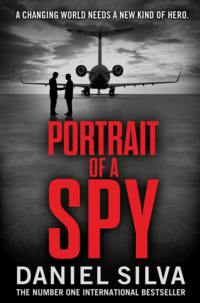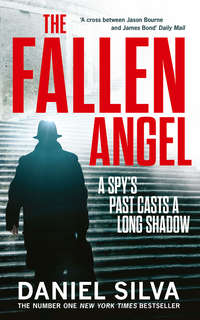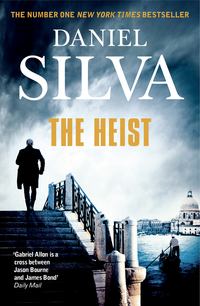
Полная версия
The Black Widow

Daniel Silva
The Black Widow

Copyright

This is entirely a work of fiction. The names, characters and incidents portrayed in it are the work of the author’s imagination. Any resemblance to actual persons, living or dead, events or localities is entirely coincidental.
HarperCollinsPublishers
1 London Bridge Street
London SE1 9GF
www.harpercollins.co.uk
First published in Great Britain by HarperCollinsPublishers 2016
Copyright © Daniel Silva 2016
Daniel Silva asserts the moral right to be identified as the author of this work
Cover layout design © HarperCollinsPublishers 2017
Cover photographs © Elisabeth Ansley/Trevillion Images (figure);
©Shutterstock.com (background)
Map designed by Nick Springer
Islamic pattern © DamienGeso/Shutterstock, Inc.
A catalogue record for this book is available from the British Library
All rights reserved under International and Pan-American Copyright Conventions. By payment of the required fees, you have been granted the non-exclusive, non-transferable right to access and read the text of this e-book on-screen. No part of this text may be reproduced, transmitted, down-loaded, decompiled, reverse engineered, or stored in or introduced into any information storage and retrieval system, in any form or by any means, whether electronic or mechanical, now known or hereinafter invented, without the express written permission of HarperCollins e-books
Ebook Edition © JULY 2016 ISBN: 9780007552375
Source ISBN: 9780007552382
Version: 2018-09-24
Dedication
For Stephen L. Carter, for friendship and faith.
And, as always, for my wife, Jamie, and my children, Lily and Nicholas.
Epigraph
The black flags will come from the East, led by mighty men, with long hair and beards, their surnames taken from their home towns.
—THE HADITH
Give me a girl at an impressionable age, and she is mine for life.
—MURIEL SPARK, THE PRIME OF MISS JEAN BRODIE
Table of Contents
Cover
Title Page
Copyright
Dedication
Epigraph
Foreword
Map
Part One
Chapter 1: The Marais, Paris
Chapter 2: Rue de Grenelle, Paris
Chapter 3: Beirut
Chapter 4: Beirut—Tel Aviv
Chapter 5: Israel Museum, Jerusalem
Chapter 6: Ma’ale Hahamisha, Israel
Chapter 7: Ma’ale Hahamisha, Israel
Chapter 8: Narkiss Street, Jerusalem
Chapter 9: The Marais, Paris
Chapter 10: Rue Pavée, Paris
Chapter 11: Amsterdam—Paris
Chapter 12: Paris
Chapter 13: Amman, Jordan
Chapter 14: Gid Headquarters, Amman
Chapter 15: Gid Headquarters, Amman
Chapter 16: Jerusalem
Chapter 17: Jezreel Valley, Israel
Chapter 18: Nahalal, Israel
Chapter 19: Nahalal, Israel
Chapter 20: Nahalal, Israel
Part Two
Chapter 21: Nahalal, Israel
Chapter 22: Nahalal, Israel
Chapter 23: Aubervilliers, France
Chapter 24: Rue du Lombard, Brussels
Chapter 25: Northern France
Chapter 26: Northern France
Chapter 27: Seraincourt, France
Chapter 28: Paris
Chapter 29: Aubervilliers, France
Chapter 30: La Courneuve, France
Chapter 31: Aubervilliers, France
Chapter 32: Santorini, Greece
Chapter 33: Santorini, Greece
Chapter 34: N Street, Georgetown
Chapter 35: N Street, Georgetown
Chapter 36: Raqqa, Syria
Chapter 37: Eastern Syria
Chapter 38: Palmyra, Syria
Chapter 39: Palmyra, Syria
Chapter 40: Anbar Province, Iraq
Chapter 41: Anbar Province, Iraq
Chapter 42: Anbar Province, Iraq
Chapter 43: Anbar Province, Iraq
Part Three
Chapter 44: Charles de Gaulle Airport, Paris
Chapter 45: Seraincourt, France
Chapter 46: Paris—Tiberias, Israel
Chapter 47: Amman, Jordan
Chapter 48: Arlington, Virginia
Chapter 49: Alexandria, Virginia
Chapter 50: Georgetown
Chapter 51: Aubervilliers, France
Chapter 52: Hume, Virginia
Chapter 53: Liberty Crossing, Virginia
Chapter 54: Dulles International Airport
Chapter 55: Arlington, Virginia
Chapter 56: Key Bridge Marriott, Arlington
Chapter 57: The White House
Chapter 58: Alexandria, Virginia
Chapter 59: Key Bridge Marriott
Chapter 60: The White House
Chapter 61: The Lincoln Memorial
Chapter 62: Liberty Crossing, Virginia
Chapter 63: Georgetown
Chapter 64: Café Milano, Georgetown
Chapter 65: Wisconsin Avenue, Georgetown
Chapter 66: Wisconsin Avenue, Georgetown
Chapter 67: Café Milano, Georgetown
Chapter 68: King Saul Boulevard, Tel Aviv
Chapter 69: Hume, Virginia
Chapter 70: Arlington, Virginia
Chapter 71: Hume, Virginia
Chapter 72: Arlington, Virginia
Chapter 73: Hume, Virginia
Chapter 74: Hume, Virginia
Part Four
Chapter 75: Washington—Jerusalem
Chapter 76: Nahalal, Israel
Chapter 77: Petah Tikva, Israel
Chapter 78: Jerusalem
Chapter 79: Jerusalem—Tiberias
Chapter 80: Bethnal Green, London
Author’s Note
Acknowledgments
About the Author
Also Written by Daniel Silva
About the Publisher
FOREWORD
I COMMENCED WORK ON THIS NOVEL before the Islamic terrorist group known as ISIS carried out a wave of shootings and bombings in Paris and Brussels that left more than 160 people dead. After briefly considering setting aside the typescript, I chose to complete it as originally conceived, as though the tragic events had not yet occurred in the imaginary world where my characters live and work. The similarities between the real and fictitious attacks, including the links to the Brussels district of Molenbeek, are entirely coincidental. I take no pride in my prescience. I only wish that the murderous, millenarian terrorism of the Islamic State lived solely on the pages of this story.


1
THE MARAIS, PARIS
IT WAS TOULOUSE THAT WOULD prove to be Hannah Weinberg’s undoing. That night she telephoned Alain Lambert, a contact at the Interior Ministry, and told him that this time something would have to be done. Alain promised a swift response. It would be bold, he assured Hannah, boldness being the default response of a fonctionnaire when in reality he planned to do nothing at all. The following morning the minister himself paid a visit to the site of the attack and issued a vague call for “dialogue and healing.” To the parents of the three victims he offered only regrets. “We will do better,” he said before returning hastily to Paris. “We must.”
They were twelve years of age, the victims, two boys and a girl, all Jewish, though the French media neglected to mention their religion in the first reports. Nor did they bother to point out that the six attackers were Muslim, only that they were youths who resided in a suburb, a banlieue, east of the city center. The description of the attack was vague to the point of inaccuracy. According to French radio, an altercation of some sort had occurred outside a patisserie. Three were injured, one seriously. The police were investigating. No arrests had been made.
In truth, it had not been an altercation but a well-planned ambush. And the attackers were not youths, they were men in their early twenties who had ventured into the center of Toulouse in search of Jews to harm. That their victims were children seemed to trouble them not. The two young boys were kicked, spat upon, and then beaten bloody. The girl was pinned to the pavement and her face slashed with a knife. Before fleeing, the six attackers turned to a group of stunned bystanders and shouted, “Khaybar, Khaybar, ya-Yahud!” Though the witnesses did not know it, the Arabic chant was a reference to the seventh-century Muslim conquest of a Jewish oasis near the holy city of Medina. Its message was unmistakable. The armies of Muhammad, the six men were saying, were coming for the Jews of France.
Regrettably, the attack in Toulouse was not without precedent or ample warning. France was presently in the grip of the worst spasm of violence against Jews since the Holocaust. Synagogues had been firebombed, gravestones toppled, shops looted, homes vandalized and marked with threatening graffiti. In all, there had been more than four thousand documented attacks during the past year alone, each carefully recorded and investigated by Hannah and her team at the Isaac Weinberg Center for the Study of Anti-Semitism in France.
Named for Hannah’s paternal grandfather, the center had opened its doors under heavy security ten years earlier. It was now the most respected such institution in France, and Hannah Weinberg was regarded as the foremost chronicler of the country’s new wave of anti-Semitism. Her supporters referred to her as a “memory militant,” a woman who would stop at nothing to pressure France into protecting its besieged Jewish minority. Her detractors were far less charitable. Consequently, Hannah had long ago stopped reading the things that were written about her in the press or in the sewers of the Internet.
The Weinberg Center stood on the rue des Rosiers, the most prominent street in the city’s most visible Jewish neighborhood. Hannah’s apartment was around the corner on the rue Pavée. The nameplate on the intercom read MME BERTRAND, one of the few steps she took to safeguard her security. She resided in the flat alone, surrounded by the possessions of three generations of her family, including a modest collection of paintings and several hundred antique lunettes, her secret passion. At fifty-five, she was unmarried and childless. Occasionally, when work permitted, she allowed herself a lover. Alain Lambert, her contact at the Interior Ministry, had once been a pleasant distraction during a particularly tense period of anti-Jewish incidents. He rang Hannah at home late after his master’s visit to Toulouse.
“So much for boldness,” she said acidly. “He should be ashamed of himself.”
“We did the best we could.”
“Your best wasn’t good enough.”
“It’s better not to throw oil on the fire at a time like this.”
“That’s the same thing they said in the summer of nineteen forty-two.”
“Let’s not get overly emotional.”
“You leave me no choice but to issue a statement, Alain.”
“Choose your words carefully. We’re the only ones standing between you and them.”
Hannah hung up the phone. Then she opened the top drawer of the writing desk and removed a single key. It unlocked a door at the end of the hall. Behind it was the room of a child, Hannah’s room, frozen in time. A four-poster bed with a lace canopy. Shelves stacked with stuffed animals and toys. A faded pinup of a heartthrob American actor. And hanging above the French provincial dresser, invisible in the darkness, was a painting by Vincent van Gogh. Marguerite Gachet at Her Dressing Table . . . Hannah trailed a fingertip over the brushstrokes and thought of the man who had carried out the painting’s one and only restoration. How would he respond at a time like this? No, she thought, smiling. That wouldn’t do.
She climbed into her childhood bed and, much to her surprise, fell into a dreamless sleep. And when she woke she had settled on a plan.

For the better part of the next week, Hannah and her team toiled under conditions of strict operational security. Potential participants were quietly approached, arms were twisted, donors were tapped. Two of Hannah’s most reliable sources of funding demurred, for like the minister of the interior they thought it better to not jeter de l’huile sur le feu—throw oil on the fire. To make up for the shortfall, Hannah had no choice but to dip into her personal finances, which were considerable. This, too, was fodder for her enemies.
Lastly, there was the small matter of what to call Hannah’s endeavor. Rachel Lévy, head of the center’s publicity department, thought blandness and a trace of obfuscation would be the best approach, but Hannah overruled her. When synagogues were burning, she said, caution was a luxury they could not afford. It was Hannah’s wish to sound an alarm, to issue a clarion call for action. She scribbled a few words on a slip of notepaper and placed it on Rachel’s cluttered desk.
“That should get their attention.”
At that point, no one of any consequence had agreed to attend—no one but a gadfly American blogger and cable television commentator who would have accepted an invitation to his own funeral. But then Arthur Goldman, the eminent historian of anti-Semitism from Cambridge, said he might be willing to make the trip down to Paris—provided, of course, that Hannah agreed to put him up for two nights in his favorite suite at the Crillon. With Goldman’s commitment, Hannah snared Maxwell Strauss from Yale, who never passed up an opportunity to appear on the same stage as his rival. The rest of the participants quickly fell into place. The director of the United States Holocaust Memorial Museum signed on, as did two important memoirists of survival and an expert on the French Holocaust from Yad Vashem. A novelist was added, more for her immense popularity than her historical insight, along with a politician from the French far right who rarely had a kind word to say about anyone. Several Muslim spiritual and community leaders were invited to attend. All declined. So, too, did the interior minister. Alain Lambert broke the news to Hannah personally.
“Did you really think he would attend a conference with so provocative a title?”
“Heaven forbid your master ever do anything provocative, Alain.”
“What about security?”
“We’ve always looked after ourselves.”
“No Israelis, Hannah. It will give the entire affair a bad odor.”
Rachel Lévy issued the press release the next day. The media were invited to cover the conference; a limited number of seats were made available to the public. A few hours later, on a busy street in the Twentieth Arrondissement, a religious Jew was set upon by a man with a hatchet and gravely wounded. Before making his escape, the assailant waved the bloody weapon and shouted, “Khaybar, Khaybar, ya-Yahud!” The police were said to be investigating.

For reasons of both haste and security, a period of just five busy days separated the press release from the start of the conference itself. Consequently, Hannah waited until the last minute to prepare her opening remarks. On the eve of the gathering, she sat alone in her library, a pen scratching furiously across a yellow legal pad.
It was, she thought, an appropriate place to compose such a document, for the library had once been her grandfather’s. Born in the Lublin district of Poland, he had fled to Paris in 1936, four years before the arrival of Hitler’s Wehrmacht. On the morning of July 16, 1942—the day known as Jeudi Noir, or Black Thursday—French police officers carrying stacks of blue deportation cards arrested Isaac Weinberg and his wife, along with nearly thirteen thousand other foreign-born Jews. Isaac Weinberg had managed to conceal two things before the dreaded knock at the door: his only child, a young son named Marc, and the van Gogh. Marc Weinberg survived the war in hiding, and in 1952 he managed to reclaim the apartment on the rue Pavée from the French family who had settled into it after Jeudi Noir. Miraculously, the painting was precisely where Isaac Weinberg had left it, hidden under the floorboards of the library, beneath the desk where Hannah now sat.
Three weeks after their arrest, Isaac Weinberg and his wife were deported to Auschwitz and gassed upon arrival. They were just two of the more than 75,000 Jews from France who perished in the death camps of Nazi Germany, a permanent stain on French history. But could it ever happen again? And was it time for the 475,000 Jews of France, the third-largest Jewish community in the world, to pack their bags and leave? This was the question Hannah had posed in the title of her conference. Many Jews had already abandoned France. Fifteen thousand had immigrated to Israel during the past year, and more were leaving every day. Hannah, however, had no plans to join them. Regardless of what her enemies might say, she considered herself French first and Jewish second. The idea of living somewhere other than the Fourth Arrondissement of Paris was abhorrent to her. Still, she felt duty-bound to warn her fellow French Jews of the gathering storm. The threat was not yet existential. But when a building is burning, Hannah wrote now, the best course of action is to find the nearest exit.
She finished a first draft shortly before midnight. It was too strident, she thought, and perhaps a bit too angry. She softened its roughest edges and added several depressing statistics to bolster her case. Then she typed it into her laptop, printed a copy, and managed to find her bed by two. The alarm woke her at seven; she drank a bowl of café au lait on the way to the shower. Afterward, she sat before her vanity in a toweling robe, staring at her face in the mirror. Her father, in a moment of brutal honesty, had once said of his only daughter that God had been generous when giving her brains but parsimonious with her looks. Her hair was wavy and dark and streaked with gray that she had allowed to encroach without resistance. Her nose was prominent and aquiline, her eyes were wide and brown. It had never been a particularly pretty face, but no one had ever mistaken her for a fool, either. At a moment like this, she thought, her looks were an asset.
She applied a bit of makeup to hide the circles beneath her eyes and arranged her hair with more care than usual. Then she dressed quickly—a dark woolen skirt and sweater, dark stockings, a pair of low-heeled pumps—and headed downstairs. After crossing the interior courtyard, she opened the main doorway of the building a few inches and peered into the street. It was a few minutes after eight; Parisians and tourists were making their way swiftly along the pavement beneath a gray early-spring sky. No one, it seemed, was waiting for an intelligent-looking woman in her mid-fifties to emerge from the apartment building at Number 24.
She did so now and headed past a row of chic clothing boutiques to the rue des Rosiers. For a few paces it seemed like an ordinary Paris street in a rather upscale arrondissement. Then Hannah came upon a kosher pizzeria and several falafel stands with signs written in Hebrew, and the true character of the street was revealed. She imagined how it must have looked early on the morning of Jeudi Noir. The helpless detainees clambering into open-top trucks, each clutching their allotted one suitcase. The neighbors staring down from open windows, some silent and ashamed, others barely able to contain their glee at the misfortune of a reviled minority. Hannah clung to this image—the image of Parisians waving good-bye to doomed Jews—as she moved through the flat light, her heels tapping rhythmically over the paving stones.
The Weinberg Center stood at the quiet end of the street, in a four-story building that before the war had housed a Yiddish-language newspaper and a coat factory. A line of several dozen people stretched from the doorway where two dark-suited security guards, young men in their twenties, were carefully searching all those who wished to enter. Hannah slipped past them and made her way upstairs to the VIP reception. Arthur Goldman and Max Strauss were eyeing each other warily across the room over cups of weak américain. The famous novelist was speaking seriously to one of the memoirists; the head of the Holocaust Museum was exchanging notes with the specialist from Yad Vashem, who was a longtime friend. Only the gadfly American commentator seemed to have no one to talk to. He was piling croissants and brioche onto his plate as though he hadn’t seen food in days. “Don’t worry,” said Hannah, smiling. “We’re planning to take a break for lunch.”







